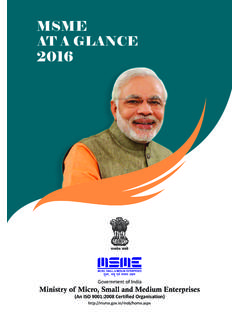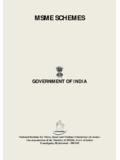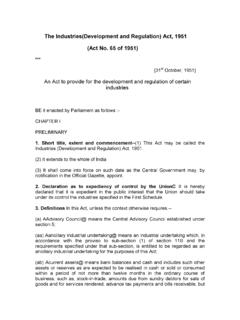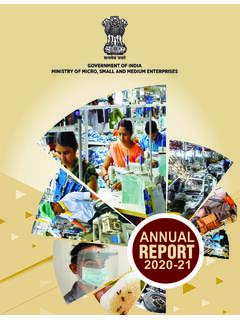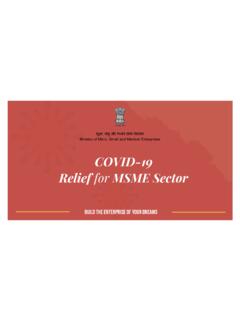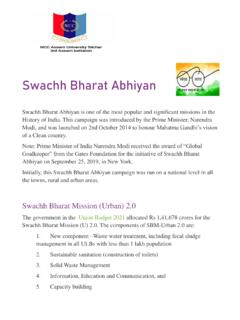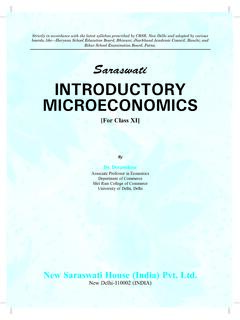Transcription of KHADI AND VILLAGE INDUSTRIES COMMISSION (Ministry of …
1 KHADI AND VILLAGE INDUSTRIES COMMISSION (Ministry of MSME ) OPERATIONAL GUIDELINES FOR THE PILOT PROJECTS OF AGARBATTI INDUSTRY UNDER POLYMER AND CHEMICAL BASED INDUSTRY(PCBI ) VERTICAL OF GRAMODYOG VIKAS YOJANA(GVY) 1. Preamble Agarbatti making is a traditional industry in India with a size of around Rs. 7500 crore annual production with involvement of about 5 lakh people and export of about Rs. 750 crores. Based on the interaction with industry on 20th August 2020, it came out that, today the industry is facing problem in the area of raw materials like saw dust, charcoal powder, Joss powder etc because of increase in Agarbatti production in last one year. In addition there is also a problem with respect to bamboo sticks being used for Agarbatti making.
2 While these raw materials may not constitute major cost towards making of Agarbatti (about 20% by these raw materials) but their indigenous production will provide good opportunity to create more jobs and also to assure regular supply of raw materials at reasonable rates. This, in the long term, will help keep the price of finished goods reasonably stable. Other important area to look into, includes inputs on fragrance and the machines manufacturing capability in the country for making Agarbatti. India is strong in the fragrance portion but needs to develop strength in machine making which is largely imported, presently. Accordingly a holistic approach is required to strengthen this traditional industry so as to sustain the present growth rate of about 10%, and to capture more and more export markets.
3 The major components of this holistic approach will be to address issues of i) Continuous support to artisans through training, financing etc. ; ii) Supply of raw material like saw dust, charcoal powder, Joss powder( a forest produce) ; ii) Increased supply of bamboo sticks through appropriate bamboo cultivation ; iv) Ensure continuous innovation in the fragrance & packaging area to ensue variety and quality at reasonable rates and to explore usage of new/ alternate raw materials like re-usable flowers, coir etc. ; v) Strengthen the machine manufacturing capability in the country at a competitive cost ; and vi) To achieve self-sufficiency in all aspects of this product. 2. Present scenario of Agarbatti production : India is one of the largest Agarbatti( incense sticks) producing countries which has captured both domestic and foreign market.
4 India has a leadership position in Agarbatti production and fulfils more than half of the world s incense sticks requirements. As on date, around 90 Agarbattis are widely used not only in India but also in 90 different foreign countries across the globe. India has got good opportunities to attain growth of this Agarbatti industry in real terms. Further, gaps have reduced to some extent as lots of manufacturers are coming up now with the support of MSME. Main challenges in this Agarbatti industry is raw material, mainly Charcoal, Joss Powder etc. Indian Agarbatti has a number of opportunities such as (i) large export market potential (ii) scope for innovations and R&D, (iii) further expansion of domestic market and iv) to provide newer and alternate raw materials at better prices.
5 For this purpose, a pilot project in the name of KHADI Agarbatti pilot project is being launched by the Ministry of MSME. 3. Objectives of KHADI Agarbatti pilot project The objectives of the KHADI Agarbatti pilot project are the following: to increase the local production capacity of Agarbatti in order to build self sufficiency in the country. to train and distribute the Agarbatti making machines to the selected artisans to create sustainable employment. to upgrade the earning capacity of artisans involved in the hand rolled Agarbatti making by providing pedal operated machines and to increase the production of Agarbatti manufactured by KHADI institutions. to provide automatic Agarbatti machines to SHGs or similar groups and entities for making them entrepreneurs and to make tie-up with the successful Agarbatti manufacturers for support including supply of raw materials with buy back arrangement of final products.
6 To provide on the job skill development training to all the selected artisans through trained Master trainers in FFDC. to tie up with the professional institutes like IITs, FFDC, Kannauj, MGIRI Wardha, MSMETC, VNIT, Nagpur, Indian Institute of Packaging etc for technology intervention in the machines, alternate raw material, packaging, etc. 4 BAMBOO : a major issue of Agarbatti industry India has vast resources of Bamboo, despite this, it has to import bamboo sticks and other bamboo products like bamboo pulp etc. for making raw Agarbatti. In the industry interaction on , this was flagged as a major problem in manufacturing of Agarbatti as India mostly imports round bamboo sticks from Vietnam and China.
7 Among raw materials for manufacturing Agarbatti like Jigat powder, joss powder, saw dust etc. bamboo stick is one of the main constituents. The core of the Agarbatti is made of split, sliced and sized bamboo of two types:- i. Square section ii. Round section Bamboo species like Bambusa Tulda, Bambusa nutans, Bambusa balcooa and Bambusa bambos are mostly used in preparation of Agarbatti sticks (both square and round types). Bambusa Tulda is the special Bamboo variety, mostly available in the North-east region and East coast which is the best suited for the Indian Agarbatti industry. For making it PAN India available, plantation of Bambusa Tulda needs to be made across the country, particularly in Agarbatti manufacturing States.
8 To achieve self-sufficiency in Bamboo species like Bambusa Tulda, efforts need to be made in consultation with M/o Agriculture by using new techniques and technologies for its large scale plantation. Also, R & D activity need to be promoted to ensure i) reduction in wastage while making Agarbatti sticks ii) and uses of square sticks etc. 5. ROLE OF KVIC IN DEVELOPMENT OF AGARBATTI SECTOR : KVIC, being pioneer in implementation of VILLAGE INDUSTRIES (VI), has helped the rural VI units in the following forms: i. Loan and subsidy provided under pattern approach to individuals through State KHADI and V. I. Boards. ii. Subsidy &Loan in the form of consortium bank credit(CBC). iii. Margin Money grant in PMEGP.
9 Iv. Conducted awareness camps, training programmes through MDTCs and Non departmental training centres. v. Marketing support through 8050 sales outlets in the country. There are a number of Agarbatti producing units of directly aided units of KVIC and in PMEGP scheme also, KVIC is assisting for setting up of units for producing and selling Agarbatti Further, KVIC will support in the following interventions based on its Research and Development through the Centre of Excellences: i. In developing automatic Agarbatti machine. ii. Providing pedal operated machines to the artisans iii. Skill development training programme. iv. New inventions and interventions in production of carbon-neutral Agarbatti, raw material, machinery, packaging, carbon-neutral certification, etc.
10 V. Quality control to meet the market standards. vi. R&D support for improvement in the efficiency of machines. vii. Strategy for supply chain tie up/forward linkages. 6. GENERAL GUIDELINES FOR SETTING UP PILOT-PROJECTS UNDER GVY for promotion and demonstration of Agarbatti production activity across the country under following categories: i) Support to artisans developing hand rolled Agarbatti with Pedal operated Machines ii) Support of Automatic Agarbatti machines to SHG/other similar groups / or groups as decided by the COMMISSION Common general guidelines for both the programs, as mentioned at para 6)-i) & ii) above : i) The pilot projects will be implemented by KVIC or through directly aided institutions of KVIC/KVIB( KHADI /VI) in the States of Bihar, uttar pradesh , Orissa, Rajasthan, Maharashtra, Karnataka etc.
